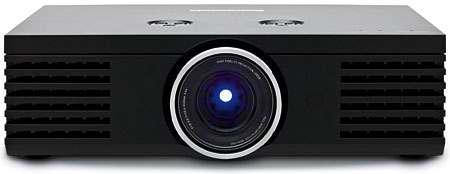Panasonic PT-AE3000U LCD Projector
 Price: $3,499 At A Glance: Incredible array of features • Great calibration flexibility • Contrast performance could be improved
Price: $3,499 At A Glance: Incredible array of features • Great calibration flexibility • Contrast performance could be improved
The Features You Want, the Price You Need
Panasonic’s PT-AE3000U really ups the ante when it comes to features at this price point. Panasonic has consistently pushed the envelope on the budget side, and this LCD projector easily represents the company’s best effort to date. It offers solid performance and the most expansive feature set you could hope to find at or near this price point.

The PT-AE3000U follows in a long line of Panasonic LCD designs. It incorporates three-chip 1080p LCD technology with an advanced dynamic iris, along with a long list of other goodies. At $3,499, this one comes in a bit lower than the Mitsubishi and at the same price point as the Sony, but it offers a much more feature-rich package.
Design
Without a doubt, the Panasonic is the most spartan of the three projectors in terms of aesthetic design. I guess Panasonic went with the “It’s what’s inside that counts” approach. The design is essentially the same as the models that came before it and features a nondescript black box with a large lens assembly on the front.
The top panel features manual adjustments for horizontal and vertical lens shift. The side has a pop-open panel where you’ll find simple controls for menu operations, lens focus, and zoom.
You can adjust the motorized focus and zoom with an onscreen test pattern that pops up when you enter the lens mode. When you press Enter on the remote twice, the Panasonic cycles to the active input, which allows the user to focus using an external pattern, which is a nice touch. Panasonic also includes a lens cover that attaches to the projector with a (removable) tether.
The back panel features a healthy number of inputs, including three HDMI 1.3 inputs, two component video inputs, and the standard S-video and composite video options. There’s also a computer RGB port and an RS-232 port for control systems. Surprisingly, Panasonic didn’t include a trigger option for powered screens.
Panasonic has outdone itself with features this time around. Not only has it included all the features we’ve come to expect from it in the past, but it’s also refined them and added some new tricks. One of particular note is the new focus/zoom memory function. As I mentioned earlier, constant-height setups are becoming all the rage, and Panasonic didn’t want to leave its customers out in the cold. In addition to supporting aftermarket anamorphic lenses, which are quite costly, Panasonic lets you use the projector as is with a 2.35:1 screen or really any screen you want to use. You simply set the zoom and focus for each aspect ratio, save them in memories, and call them up as needed based on the material you’re watching.

With a 2.35:1 source on a 2.35:1 screen (the most likely combination), the Panasonic’s memory function can zoom out the image to fill the full width of screen. But it can’t eliminate the black bars in a 2.35:1 source (as an anamorphic lens setup can). Instead, it simply shifts the bars into the area above and below the screen. You’ll want to be sure those areas are dark enough to absorb the low light levels in the black bars. I would recommend some dark material above and below the black screen frame. (The black bars will usually be wider than the frame.)
If you use a 2.35:1 screen, you’ll still have black bars on the sides of the image with non-2.35:1 program material, so you may still want to get a masking system for the sides. Given the money you’ll save by not having to invest in an anamorphic lens, this may be a reasonable option.
Another really cool feature in the PT-AE3000U is a built-in waveform monitor. This is a geek’s dream, and I’m surprised that more manufacturers don’t offer something like it. With the touch of a button, you can bring up a real-time waveform monitor that gives you the information for any part of the image, including IRE levels for each individual color. This works great for calibration, as it gives you the absolute level of any portion of the video signal. This is the same type of system that post-production facilities use to master video. If you’re a tweaker, you’ll want to get your hands on one of these.
Setup
The PT-AE3000U is definitely the most fully featured projector in this roundup in terms of calibration and setup. Panasonic gives you access to the full complement of setup options, including gray scale, color management, and gamma calibration. It also lets you save your setups in one of the 16 available user memories, each with its own customized label.
- Log in or register to post comments

























































